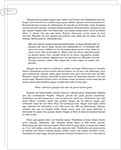 Study Document
Study Document
Public Health Vs. Privacy Rights: Case Study
Pages:2 (580 words)
Sources:1
Subject:Health
Topic:Public Health
Document Type:Case Study
Document:#46681519
3. In what form or forms does the conflict between outcomes and actions present itself in this scenario?
On one hand, testing as many people as possible for AIDS, and specifically focusing testing programs upon high-risk groups seems like a good idea, given that it should result in the positive outcome of reducing the amount of unaware people engaged in high-risk sexual behavior who could infect other individuals. However, there is the issue of engaging in unfair, discriminatory testing practices and encouraging societal prejudice against a particular group that has a disproportionate number of individuals infected with AIDS.
4. Does mandatory named neonate testing sound, at first hearing, like a good idea? What about the proposal of some AIDS scholars for a testing program aimed at particular subpopulations based on statistical estimates of underlying infection rates or risky behavior patterns? At first look, does the Nahmias-Feinstein proposal for screening strategies seem like a good idea?
While on the surface neonatal and population-specific testing may sound like a good idea, this could result in individuals being labeled for life, either from an early age, or as potential carriers because of a test subject's membership in a particularly stigmatized population. Focusing on a particular population, then criminalizing those who test positive and engage in unsafe sexual practices is also counter-productive to encouraging test participation. A population-specific program in a legal and social world hostile to HIV-positive people, AIDS patients, and gay men in general would ultimately seem ineffective, if those who tested positive felt condemned to physical and social 'deaths.' It could also discourage mothers from having their children
Related Documents
 Study Document
Study Document
Public Health Officials Using Computers to Manage Outbreaks
Digital Disease Detection, commonly referred to as digital epidemiology provided strategies and methods for allowing digital-technology users to monitor infectious disease and conduct surveillance. These strategies help in the understanding of concerns and attitudes regarding infectious diseases. The process begins with the basics, such as the availability of internet access, online sharing platforms and other digital devices. These sources offer huge amounts of data. It is important to note that
 Study Document
Study Document
Effects on Public Health of Health Care Reform
Health Care Reform Effecting Public Health United States Healthcare reform is an integral part of the United States healthcare system. Below is an evaluation of the effects healthcare reform has had on healthcare in the U.S. Internet sources as well as peer-reviewed journals will be looked at so as to see the effects. The cost of healthcare has been on the rise. Issues of healthcare quality ought to be paid attention to
 Study Document
Study Document
Federal, State, County Public Health Resources Comparison
Federal, State, County Public Health Resources Comparison Paper: Federal, State, and County Public Health Resources Comparison Paper: Federal, State, County Public Health Resources Comparison Paper Federal, State, County Public Health Resources In most cases, public health serves everyone from everywhere. They work on things that affect everyone at large; things such as bird flu. Community health deals with health care professionals like nurses and doctors and is concerned with the needs of a certain
 Study Document
Study Document
Settings for Public Health Practice
There is confusion about laws which are subject to different interpretations and this result in critical information not being made available. This is caused by such laws like the "Educational Rights and Privacy Act -- FERPA, Health Insurance Portability and Accountability Act -- HIPAA and a number of legislations that seek to protect the privacy of the family." ("Report to the President on Issues Raised by the Virginia Tech
 Study Document
Study Document
Health Information Exchange in the US
Health Information Exchange BOON OR BANE? Health Information Exchange in the U.S. The Guidelines Benefits Privacy and Security Challenges and Strategies Why Clinicians Use or Don't Use HIE Doctors' Opinion on HIE Consumer Preferences around HIE Health Information Exchange or HIE is a system, which allows the immediate electronic access of a person's health information records by a health provider (Fricton and Davies, 2008). The overall objective is to improve the safety and quality of health, especially for emergency care.
 Study Document
Study Document
Healthcare Management Information Systems Telemedicine
Therefore in the economic sense many institutions have been viewed to lay back. Knowledge and Expertise in Telemedicine Another challenge has to do with the limited knowledge and expertise in telemedicine as well as the need for enhanced and modified telemedicine systems. In this sense, little knowledge currently exists among medical practitioners on how to effectively and practically use various forms of telemedicine. This knowledge gap on insight into telemedicine, in



